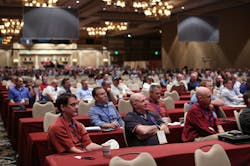LAS VEGAS — Gathering together nearly 1,000 plumbing and HVAC contractors, vendors and other invited guests is a feat, but Uponor has pulled it off on a biennial basis, and this year’s fest of all things Uponor at the Bellagio Hotel and Casino here was the biggest Uponor Convention yet.
Uponor packs its meeting with educational seminars, holds its own small trade show, and has some fun too. Millennial Ryan Avery kicked off the convention telling contractors how to deal with his generation. Some of the things Avery mentioned weren’t surprising to anyone who has been paying attention: “Boomers wanted to build an empire,” Avery said, “Millennials want to build a community.”
But he also surprisingly told the Boomers and Gen Xers in the room to put down their phones when they’re talking to Millennials. A lot of Millennials don’t feel valued at work, he pointed out, because their time isn’t valued.
Dale Stroud, senior director of marketing/offerings and never a shrinking violet, came on stage in a sun costume as Mr. Mostly Sunny. In addition to favorable economic conditions, Stroud pointed out that two-thirds of the nation’s housing inventory is more than 30 years old and about half of segment is more than 50 years old, making them prime candidates for re-piping. That was followed up during the convention with a session by Jeff Butler, president of vendor Re-pipe Specialists, put the repiping market at $2 billion, bigger than the new construction market.
Uponor has emphasized the commercial side of its business the last couple of years since it began producing PEX pipe in sizes up to 3-inches. It demonstrates to contractors how to design and install large-diameter PEX, complete with hangers, brackets and pipe supports, at every trade show at which it exhibits. Holdrite was one of the exhibitors at the trade show as well as Milwaukee Tool with its M18 Force Logic ProPEX expansion tool.
To reinforce that message, one session focused on use of PEX on a net-zero office building built for the National Renewable Energy Laboratory in Golden, Colorado, a 220,000-sq.ft. LEED Platinum project that’s the largest net-zero building in the world. NREL engineer Paul Torcellini, who acted as the owner’s rep on the job, spearheaded the project.
Torcellini laid out the numbers to debunk the notion that net zero is too expensive. If an office building typically uses 90,000 Btu/sq.ft./year, you could knock off 20,000 Btu just by building it to code. You could cut it in half by building to the state-of-the-art. Cover half the roof with photovoltaic panels and now you’re down to 12,000 Btu. Builders do things that waste both money and energy, he noted, such as decorative fountains. Or they waste energy to save money and call it value engineering.
The NREL team laid out its goals, including making the structure LEED Platinum and Energy Star Plus rated, and the design team came up with solutions, including use of radiant PEX rollout mats. Using radiant saved money by reducing the size of mechanical rooms and minimizing the amount of ductwork. The building cost $250/sq.ft. to build.
Also on the commercial side, Don Rasmusson, an MEP applications engineer with CAD Technology Center Inc., walked the contractors through incorporating PEX hydronic piping into the BIM model.
BIM is not a specific piece of software, Rasmussen pointed out. It’s a lot of software from a variety of vendors that work in concert. The next step in BIM is coordinated data in which the BIM model becomes a communication tool with the aim of increasing efficiency. Seventy-four percent of contractors use BIM, he noted, more than the percentage of architects and engineers that use BIM. In the very near future, look for BAM, the Building Assembly Model used for shop fabrication of assemblies, and BOOM, the Building Operation Optimization Model. Operations and maintenance are a much bigger thing over time than the initial design work.
And, finally, one of CONTRACTOR’s favorite contractors, our columnist Eric Aune, Aune Plumbing & Heating, Zimmerman, Minnesota, gave fellow contractors the low-down on radiant zoning options.
About the Author
Robert P. Mader
Bob Mader is the Editorial Director for Penton's mechanical systems brands, including CONTRACTOR magazine, Contracting Business and HPAC Engineering, all of which are part of Penton’s Energy and Buildings Group. He has been with CONTRACTOR since 1984 and with Penton since 2001. His passions are helping contractors improve their businesses, saving energy and the issue of safeguarding our drinking water. He is a graduate of the University of Notre Dame with an A.B. in American Studies with a Communications Concentration.


